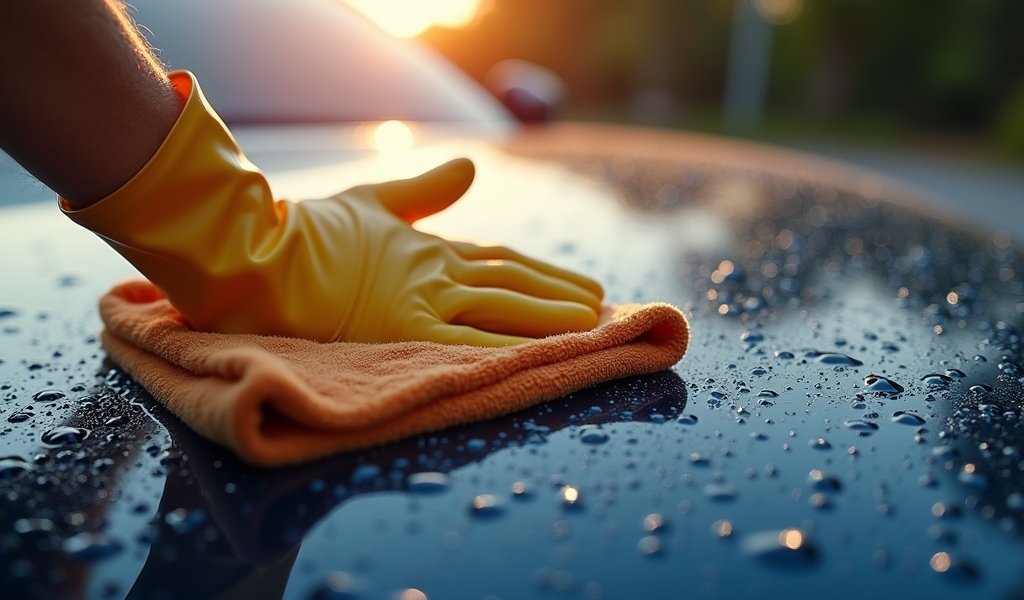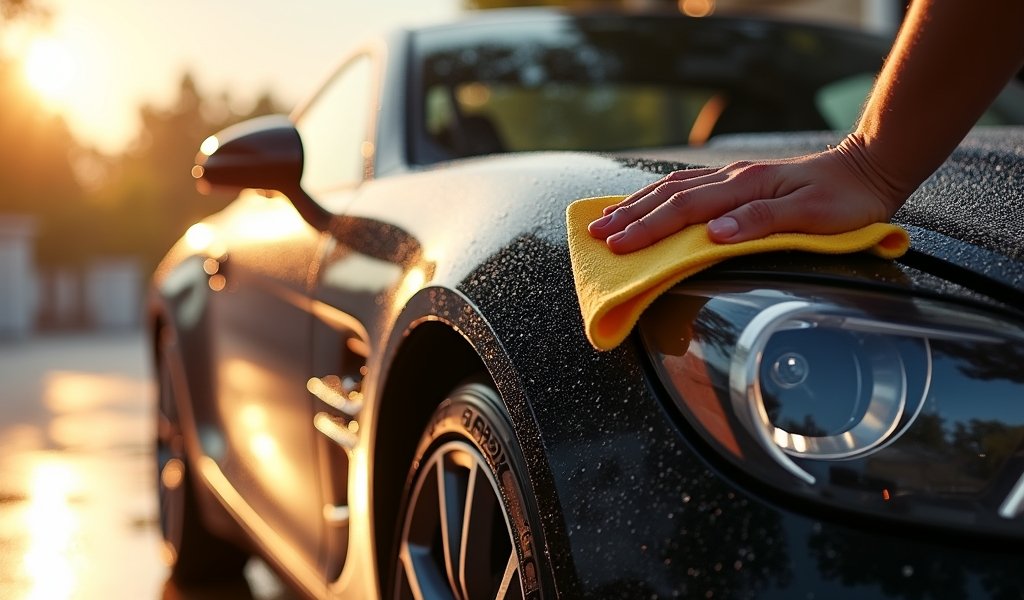Overview
This guide provides essential tips for effective car waxing, including proper preparation, timing, product selection, application techniques, and maintenance strategies to maximize paint protection and appearance. Proper waxing creates a protective barrier against environmental contaminants, enhances your vehicle’s shine, and maintains its value when done correctly with attention to surface preparation, weather conditions, and using appropriate techniques.
Table of Contents
- Understanding Car Wax: Why It Matters After Washing
- The Perfect Timing: When to Apply Wax After Washing
- Essential Tip #1: Proper Pre-Wax Preparation
- Essential Tip #2: Choosing the Right Wax for Your Vehicle
- Essential Tip #3: Mastering the Application Technique
- Essential Tip #4: Weather Considerations for Waxing
- Essential Tip #5: Post-Wax Care and Maintenance
- Common Mistakes to Avoid When Waxing
- Conclusion: Protecting Your Investment
- Frequently Asked Questions
Understanding Car Wax: Why It Matters After Washing
Applying car wax after washing isn’t just another step in vehicle maintenance—it’s an essential protective measure that can significantly extend your car’s aesthetic life. As a professional who’s seen thousands of vehicles over the years, I can tell you that regular waxing makes a world of difference between cars that maintain their showroom shine and those that quickly lose their luster.
Car wax after washing creates a sacrificial barrier between your paint and environmental contaminants. Think of it as a protective shield against UV rays, acid rain, bird droppings, tree sap, and other elements that constantly bombard your vehicle. Without this protection, these contaminants can gradually eat away at your clear coat, eventually leading to oxidation and permanent damage.
Beyond protection, waxing delivers that deep, wet-looking shine that makes any car—regardless of age—look spectacular. The polymers in quality waxes fill microscopic imperfections in the paint, creating a smooth surface that reflects light more evenly. This is why a freshly waxed car has that mirror-like finish that turns heads.
Regular waxing also makes subsequent car detailing sessions much easier. Dirt and grime have a harder time bonding to a waxed surface, which means less scrubbing and a reduced risk of introducing swirl marks during routine washing.
The Perfect Timing: When to Apply Wax After Washing
Timing is everything when it comes to car wax after washing. The surface must be completely clean and dry before application—this isn’t just a suggestion but a requirement for optimal results. Applying wax to a wet or damp vehicle is one of the most common mistakes I see in my shop, and it dramatically reduces both the effectiveness and longevity of the wax.
After washing your vehicle, you need to ensure it’s completely dry before proceeding with waxing. Any trapped moisture under the wax can lead to streaking, spotting, and uneven application. In professional detailing, we typically allow at least 30 minutes of air-drying time after thorough towel drying, especially in humid conditions.
Temperature plays a crucial role too. The ideal conditions for waxing are on a mild day (between 55-85°F) when the surface of the car isn’t hot to the touch. If you can place your hand comfortably on the hood or roof without feeling excessive heat, you’re good to go. Working in extreme temperatures—either too hot or too cold—can affect the wax’s ability to bond properly with your paint.
According to Consumer Reports’ testing, most modern waxes perform best when applied in a shaded area rather than direct sunlight. This prevents the wax from drying too quickly, which can make removal difficult and potentially lead to hazing.

Essential Tip #1: Proper Pre-Wax Preparation
Proper preparation is what separates amateur results from professional-quality finishes when applying car wax after washing. I’ve seen countless customers who rush through this critical step, then wonder why their wax job doesn’t last or look as good as it should.
Start with a thorough washing using a pH-balanced car shampoo—never dish soap or household cleaners, which can strip existing protection and potentially damage your paint. Two-bucket washing method is preferred: one bucket with soapy water and another with clean rinse water to prevent redepositing contaminants onto your paint.
After washing, evaluate whether your paint needs clay bar treatment. Run your hand inside a plastic bag over the surface—if it feels rough like sandpaper, your paint has embedded contaminants that washing alone won’t remove. Clay bar treatment will gently pull these particles out, creating a glass-smooth surface for wax to adhere to properly.
For vehicles with noticeable oxidation, swirl marks, or light scratches, consider polishing before waxing. Polishing removes a microscopic layer of clear coat to level the surface and restore clarity. This step is optional for newer vehicles but can dramatically improve results on older cars with visible imperfections.
Proper drying technique is crucial. Use microfiber drying towels with a minimum of 350 GSM (grams per square meter) density and pat dry rather than wipe to minimize the risk of introducing swirls. For professional results, consider using a leaf blower to force water out of crevices, mirrors, and other areas where it might hide, only to run down your freshly waxed panels later.
Finally, use an isopropyl alcohol solution (mixed 1:1 with distilled water) to remove any leftover soap residue, polish oils, or previous wax before applying new protection. This ensures proper bonding and maximum durability of your fresh coat of wax.
Essential Tip #2: Choosing the Right Wax for Your Vehicle
Not all car waxes are created equal, and selecting the right formula for your specific vehicle makes a tremendous difference in both appearance and protection. After washing your car, the wax you choose should complement your car’s paint type, age, and your regional climate.
For newer vehicles with perfect or near-perfect paint, a pure carnauba wax delivers unmatched depth and gloss. These natural waxes bring out a warm, wet-looking shine that’s particularly stunning on darker colors. However, they typically last 1-2 months before needing reapplication, which is their primary drawback.
Synthetic polymer sealants offer significantly longer protection—often 4-6 months—making them ideal for daily drivers or those who don’t enjoy frequent waxing sessions. While they may not quite match the warm glow of carnauba, modern formulations come extremely close while offering superior resistance to environmental contaminants.
For the best of both worlds, many professionals (myself included) recommend hybrid waxes that combine natural carnauba with synthetic polymers. These formulations offer the deep shine of carnauba with extended durability approaching that of synthetic options.
Consider your application preference as well. Traditional paste waxes require more effort but often deliver the most durability and depth. Liquid waxes spread more easily and work well for larger vehicles. Spray waxes offer convenience for quick maintenance but typically provide shorter protection periods.
If you live in an area with extreme weather conditions, choose accordingly. Hot, sunny climates demand UV-resistant formulations, while areas with heavy precipitation benefit from hydrophobic properties that actively repel water. Those dealing with heavy road salt in winter should prioritize corrosion-resistant formulations to protect their car paint from these harsh chemicals.
Essential Tip #3: Mastering the Application Technique
The way you apply wax after washing your car significantly impacts both the finish quality and protection duration. I’ve seen many car enthusiasts buy premium products only to apply them incorrectly, resulting in subpar results despite their investment.
First, work in sections no larger than 2×2 feet. This ensures the wax doesn’t dry out before you have a chance to buff it off. For beginners, I recommend starting with horizontal panels like the hood or trunk lid, as they’re easier to work with than vertical surfaces.
Apply wax using the right applicator—foam applicators work well for paste waxes, while microfiber applicators are better suited for liquid formulations. Use gentle, overlapping circular or straight-line motions with light pressure. The old saying “less is more” absolutely applies here—a thin, even coat bonds better and is easier to remove than thick, globby application.
When it comes to removing the wax, timing is critical. Most products have a “swipe test”—when you can run your finger through the haze and it wipes clean with minimal resistance, it’s ready for removal. Use a premium microfiber towel with at least 350 GSM density, folding it into quarters to provide multiple clean surfaces as you work.
For removing wax, use gentle straight-line motions rather than circles to minimize the risk of swirls. Turn to a fresh section of your microfiber towel frequently. If you encounter stubborn areas where the wax has dried too long, a quick spritz of quick detailer on your microfiber can help loosen it without removing the protection you’ve just applied.
Pay special attention to trim, rubber, and plastic components. Modern waxes generally won’t leave white residue on these areas, but if you’re using a traditional carnauba, be careful around these spots or use masking tape to protect them. If residue does occur, a dedicated trim restorer or even a pencil eraser can help remove it without damaging the components.

Essential Tip #4: Weather Considerations for Waxing
Weather conditions play a crucial role in achieving optimal results when applying car wax after washing. Throughout my career working with vehicles in various climates, I’ve discovered that environmental factors can make or break your waxing efforts, regardless of product quality or application technique.
Temperature range is perhaps the most critical factor. Most car waxes perform optimally between 55°F and 85°F (13°C-29°C). In colder temperatures, wax becomes thicker and harder to spread evenly, while excessive heat can cause premature drying before proper bonding occurs. For best results, check your specific product’s temperature recommendations—they can vary slightly between formulations.
Humidity affects both application and curing. High humidity extends drying time, which can be beneficial for giving you more working time with the product. However, extremely high humidity can prevent proper curing, potentially leading to water spotting or streaking. In humid conditions, work in even smaller sections and be patient with drying times.
Direct sunlight is the enemy of proper waxing. When possible, work in a garage or shaded area. If that’s not an option, try to wax during early morning or late afternoon when the sun is less intense. A surface temperature gauge is a worthwhile investment for serious detailers—if your panel temperature exceeds 90°F, consider postponing your waxing session.
Wind presents two challenges: it accelerates drying time (potentially causing the wax to dry before proper buffing) and can carry dust or debris onto your freshly prepared surfaces. If working outdoors on a windy day, position your vehicle to minimize exposure and consider using a detailing spray alongside your buffing process to provide lubrication if the wax dries too quickly.
Seasonal considerations also matter. In spring, pollen can be a major contaminant—consider waxing after a rain shower when pollen counts are temporarily reduced. In autumn, falling leaves and sap present unique challenges, making covered locations preferable. The Edmunds automotive experts recommend adjusting your entire car care schedule seasonally for best results.
Essential Tip #5: Post-Wax Care and Maintenance
The care you provide after applying car wax after washing dramatically influences how long that protection lasts. Many car owners invest time in proper washing and waxing only to undermine their efforts with improper maintenance practices afterward.
For the first 24 hours after waxing, avoid driving in harsh conditions if possible. Fresh wax needs time to fully cure and bond with your paint, typically 12-24 hours depending on environmental conditions and product formulation. During this period, avoid car washes (even touchless ones) and try not to expose the vehicle to rain, heavy dew, or environmental contaminants.
Adopt proper washing techniques between waxing sessions. Use pH-neutral car wash soaps specifically designed to preserve wax protection—avoid harsh detergents or all-purpose cleaners that can strip away your protective layer. Always use separate wash mitts for your wheels and painted surfaces to prevent cross-contamination.
Incorporate spray wax or quick detailers during your routine maintenance to extend protection. These products aren’t replacements for a full waxing session but serve as excellent “boosters” that can add weeks to your protection while enhancing the shine. They’re particularly useful after removing bird droppings, tree sap, or other contaminants that might have compromised your wax in specific areas.
Develop a regular inspection habit. Run your fingers over the paint surface after washing—when water no longer beads tightly or the surface begins to feel less slick, it’s time for reapplication. Don’t wait until your protection has completely failed, as this leaves your paint vulnerable to damage.
Consider seasonal waxing at minimum, with many professional car detailing experts recommending quarterly application for daily drivers. Garage-kept vehicles generally require less frequent waxing than those constantly exposed to the elements. Climate plays a role too—vehicles in extreme environments (coastal areas, regions with heavy snowfall and road salt, or exceptionally sunny locales) benefit from more frequent protection.
Common Mistakes to Avoid When Waxing
Throughout my years working with vehicles, I’ve witnessed recurring mistakes that prevent car owners from achieving professional-quality results when applying car wax after washing. Avoiding these pitfalls will significantly improve your outcomes.
Waxing a dirty vehicle tops the list of common errors. Even if your car appears clean, microscopic contaminants can cause scratches during the waxing process. Always wash thoroughly, and consider clay bar treatment before waxing to remove embedded contaminants that washing alone won’t address.
Applying wax in direct sunlight or on hot surfaces causes the product to dry too quickly before it can bond properly with your paint. This results in difficult removal and subpar protection. Always work in shade on cool surfaces for best results.
Using too much product is counterproductive. A thin, even layer bonds better and is easier to remove than thick application. Most professionals can wax an entire vehicle with just a few tablespoons of quality product—if you’re using significantly more, you’re likely applying too heavily.
Incorrect removal techniques often introduce swirls and marring. Use only clean, high-quality microfiber towels (never cotton or terry cloth), and employ straight-line motions rather than circular buffing. Fold your towel regularly to present a clean surface as you work.
Neglecting proper preparation steps like decontamination, polishing (when needed), and paint cleaning saves time initially but compromises your final results. The quality of your base surface determines the quality of your finished product—cutting corners in preparation inevitably leads to disappointed outcomes.
Using incompatible products can cause issues ranging from streaking to actual product failure. Some synthetic sealants don’t layer well with natural waxes, and certain spray detailers can degrade specific wax formulations. Research product compatibility or stick with products from the same manufacturer designed to work together.
Conclusion: Protecting Your Investment
Applying car wax after washing isn’t merely an aesthetic concern—it’s a crucial step in preserving one of your most significant investments. The time and effort you dedicate to proper waxing techniques pay dividends through extended paint life, easier maintenance, and retained vehicle value.
Throughout this guide, we’ve explored the essential aspects of car waxing: understanding the importance of wax as a protective barrier, timing your application correctly, preparing your surface thoroughly, selecting the right product for your specific needs, mastering application techniques, considering weather factors, and maintaining your protection through proper care.
Remember that consistency often trumps perfection. A regular waxing schedule with good technique using quality products will yield better long-term results than occasional “perfect” applications separated by long periods of neglect. Start with quarterly waxing as your baseline, adjusting frequency based on your specific environmental conditions and vehicle usage patterns.
The satisfaction of maintaining a beautifully preserved vehicle extends beyond pride of ownership. A well-maintained, regularly waxed car typically commands higher resale value and requires fewer costly paint corrections over its lifetime. What might seem like an investment of time now becomes a financial benefit later.
Whether you’re preserving a cherished classic, maintaining a daily driver, or preparing a vehicle for sale, proper waxing remains one of the most accessible yet effective forms of protection available to every car owner. With the techniques outlined in this guide, you’re well-equipped to achieve professional-quality results at home.
Frequently Asked Questions
How long should I wait to wax my car after washing?
Wait until your car is completely dry, typically 30-60 minutes after washing. Any moisture trapped under wax can cause streaking and prevent proper bonding.
Can I wax my car in direct sunlight?
Avoid waxing in direct sunlight as it causes wax to dry too quickly and become difficult to remove. Always work in a shaded area on cool panels for best results.
How often should I wax my car?
Most vehicles benefit from waxing every 3-4 months, but this varies based on climate and storage conditions. Watch for diminished water beading as your sign it’s time to reapply.
What’s the difference between car wax and polish?
Polish removes a thin layer of clear coat to eliminate imperfections and restore shine. Wax adds a protective layer over your paint without removing material.
Should I clay bar my car before waxing?
Clay barring before waxing is recommended if your paint feels rough after washing. This removes embedded contaminants that washing misses, allowing wax to bond more effectively with your paint.

